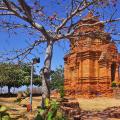The Slavs took the construction of a new house very seriously, because they had to live in it for many years. A place for the future dwelling and trees for construction were selected in advance. Pine or spruce was considered the best wood: a house made of it turned out to be strong, a pleasant coniferous smell emanated from the logs, and people in such a house were less likely to get sick. If there was no coniferous forest nearby, then oak or larch was cut down. Construction began in late autumn. Peasants from all over the village felled the forest and built a log house without windows and doors right on the edge of the village, which remained standing until early spring. This was done so that the logs "lay down" during the winter, rubbed against each other.
In early spring, the blockhouse was dismantled and transferred to the chosen place. The perimeter of the future house was marked directly on the ground with a rope. For the foundation, along the perimeter of the house, they dug a hole 20-25 cm deep, covered it with sand, laid it in boulders or tarred logs. Later they began to use a brick foundation. Birch bark layers were laid on top in a dense layer, they did not let water through and protected the house from dampness. Sometimes a quadrangular log crown was used as a foundation, installed around the perimeter of the house, and log walls were already laid on it. According to the old pagan customs, which even today the Russian people get along with the true Christian faith, a piece of wool (for warmth), coins (for wealth and prosperity), incense (for holiness) were laid under each corner of the crown.
During the construction of the house, even the number of logs in the walls mattered, it was different, depending on the customs adopted in the area. There were many ways to fasten the logs at the corners, but the most common were two - "in the field" and "in the paw". In the first method, uneven protrusions remained in the corners of the house, which were called the remainder. We have known such houses from childhood from illustrations to Russians. folk tales... But the protruding parts of the logs in the huts were of particular importance - they protected the corners of the house from freezing in the frosty winter. But the "in the paw" log house allowed expanding the space of the house. With this method, the logs were connected to each other at the very ends, it was much more difficult, so this method was used less often. In any case, the logs were very tightly adhered to each other, and for greater thermal insulation, the cracks were pierced with moss and caulked.
The sloping roof was laid out with chips, straw, aspen planks. Oddly enough, the thatched roof was the most durable, because it was filled with liquid clay, dried in the sun and became strong. A log was laid along the roof, decorated with skillful carvings from the facade, most often it was a horse or a rooster. It was a kind of amulet that protects the house from harm. Before starting the finishing work, a small hole was left in the roof of the house for several days, it was believed that through it the evil spirits should fly out of the house. The floor was covered with halves of logs from door to window. Between the foundation and the floor, there was a space that served as an underground for storing food (basement), here the owner could arrange a workshop, and in winter they kept cattle in the basement. The room itself was called a cage, one could enter it through a low door with a high threshold, the windows in the Russian hut were small, usually there were three of them on the front side and one on the side.
The Russian hut usually had one room. The main place in it was occupied by the oven. The larger the oven was, the more heat it gave, in addition, food was cooked in the oven, the elderly and children slept on it. Many rituals and beliefs were associated with the stove. It was believed that a brownie lived behind the stove. The litter could not be taken out of the hut, and it was burned in a furnace.
When matchmakers came to the house, the girl climbed onto the stove and watched the conversation between the parents and the guests from there. When she was called, she got off the stove, and this meant that she agreed to get married, and the wedding invariably ended with an empty pot being thrown into the stove: how many shards were broken, so many children would be young.
Next to the stove was the so-called "woman's corner". Here women cooked food, did handicrafts, kept dishes. It was fenced off from the room by a curtain and was called "kut" or "zakut". The opposite corner was called "red", a saint, an icon stood here, an icon lamp hung. In the same corner there was a dining table with benches. Wide shelves were nailed along the walls under the ceiling, on which there were festive dishes and boxes that served as decoration for the house, or the things needed in the household were kept. In the corner between the stove and the door, a wide shelf was set in under the ceiling.
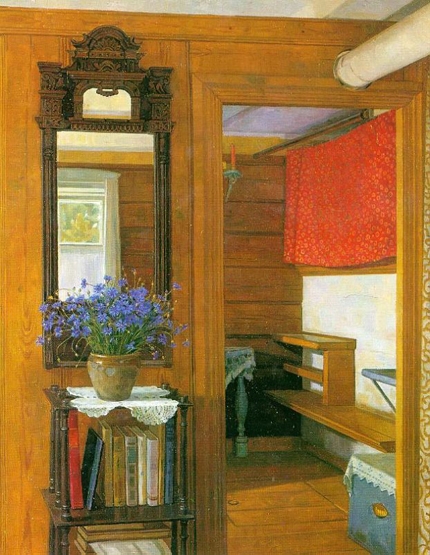
In the old Russian hut there was not so much furniture: the already mentioned table, benches along the walls, on which they not only sat, but also slept, a small open cupboard for dishes, several massive chests upholstered with iron stripes for storing clothes and linen - that's, perhaps, and all the furnishings. The floors were covered with knitted or woven rugs, and outerwear served as blankets.
According to the old tradition, the first cat was allowed into the house, and only then they entered themselves. In addition, hot coals in a pot were taken from the old house, as a symbol of the hearth, they brought a brownie in a bast shoe or felt boot, icons and bread.
Simple peasants lived in log huts, and boyars and princes built bigger houses for themselves and decorated them with richer ones - towers and chambers. A tower was called a high and light living room, built above the entryway or simply on a high basement. A staircase with a high porch, decorated with carvings and resting on carved wooden posts, led to the tower.
The room itself was often painted and also decorated with carvings, forged gratings were inserted into the large windows, and the high roof was even covered with real gilding. In the mansion there were rooms and rooms, in which, according to folk tales, beautiful girls lived and spent all their time at handicrafts. But there were, of course, other rooms in the mansion, connected by passages and stairs.
Until the 16th century, houses in Ancient Rus were wooden, they often burned, so that practically nothing remained of the buildings of those times. In the 16th century, stone buildings appeared, and then brick ones. They are built on the same principle as wooden houses, even stone carving repeats the motifs characteristic of wooden architecture, but the common people preferred to live in log huts for several centuries. So it was more familiar, and healthier, and cheaper.

Plan
Introduction
1 Crate
2 Izba
3 Mansions
3.1 Quarter mansions
3.2 Restless mansions
3.3 Outbuildings
4 Sub-base
5 Upper room
6 Svetlitsa
7 Canopy
8 Terem
9 Roof
10 Stairs
11 Gate
12 Windows
13 Construction professions
14 Gallery
15 Museums
Bibliography
Introduction
Russian national dwelling- in Russian traditional culture, which was widely used in late XIX- at the beginning of the XX centuries, it was a building made of wood (hut), built using a log or frame technology. Less often, mainly in the south, there were stone, adobe dwellings. It almost never occurs in its traditional form, but its traditions are preserved in the architecture of rural dwellings, as well as in summer cottage construction.
The basis of the Russian national dwelling is the cage.
The cage is a rectangular structure made of wood or stone. Used for summer residence. The heated cage was called a hut.
Wealthy homeowners called a large crate a grill. In the gridnitsa, feasts were given to boyars, gridis, centurions, etc. Gridnitsa is the reception. At a later time, instead of the word gridnitsa, they began to use the name povalush, canteen hut. The inner walls of the tumblers in rich houses were painted. The tumbleweed was placed at a distance from the living quarters, usually in front of the mansion.
The bedroom was called the false, or odrina. Bozhnitsa is a home church.
Logs contacted in a screech , in the undercut , in the paw , to the castle , in a mustache... Cant contacted in a mustache , in a bar , in the joint , into the corner... One row of logs or beams is a crown. The height of the stand was measured in rims, for example, "the height on the fifth rim".
The cage was installed on the sole, i.e. directly on the ground, on poles, cuts and stumps. Dir and stumps are a prototype of the foundation.
The logs were laid with moss, such a structure was called "in moss". Rich people insulated their mansions with low-quality flax, hemp, and tow. Walls and ceilings were upholstered with linen or felt.
The floors were laid on luggage, or beds. In basements, the floor could be logs. The ceiling (ceiling) was laid on the mat. The ceiling is made of split logs or beams.
The interior decoration of the cage was called "decorate the insides". The inner walls were sheathed with planks, or lime planks. The ceiling was covered with clay. Sifted earth was poured over the ceiling for insulation.
Hut (istba, firing, grydnya) - a heated cage. The hut was heated in black. The smoke came out through a wooden chimney (chimney), or through open windows and doors.
Poor people's huts were black and underground, i.e. installed directly on the ground.
The windows at the black hut are from 6 to 8 vershoks in length, 4 vershoks in width - designed to release smoke. They were located almost under the ceiling, they did not have frames. Such windows were called drag windows - they were covered with a board or a special cover. For wealthy people, a cage with drag windows was installed opposite the hut - a summer dwelling. The covered passage between the hut and the cage is the canopy. A blind basement (bryozoan) was located under the cage, in which livestock was kept, or a pantry was arranged.
Rich people have white huts - with a chimney.
Mansions are a collection of buildings in one yard. All buildings were erected in separate groups, which were connected by passageways or passages. Thus, the mansions consisted of several mansions.
Tsars (princes) lived on the upper floors. The lower floors were initially called logs, and then the basement.
The mansions were built without a definite plan. Huts, rooms, porches, porches were added to existing buildings as needed and where it was convenient for the owner. No attention was paid to the symmetry of the building.
Large mansions were reinforced with iron: brackets, squares, bases, etc.
The mansions were divided into:
3.1. Quiet mansions
Quiet (bed) mansions - living quarters. Usually there are three or four upper rooms: the front vestibule, the cross or prayer room, and the bed room. In addition to these rooms, there could also be: a front room, a back porch and others. Often the rooms did not have special names, but the third (after the front porch and the front hall), the fourth, etc. were called. The soap-room (bathhouse) was often located in the basement of the detainees in a chorus.
The princess’s half, the mansions of children and relatives were set apart from the owner’s choir, and were connected by passages and entryways.
Quarter mansions were set in the back of the courtyard.
3.1. Quiet mansions
Restless mansions - non-residential premises for ceremonial meetings, receptions, feasts, etc. The resting mansions consisted of large rooms. They were arranged in the front part of the chorus, in front of the residential mansions. The premises of the non-combatants were called the chorus, the canteen hut, the tumbled down, the upper room.
For about 200 years, the 495 m² hall of the Faceted Chamber remained the largest hall in Russian architecture.
3.3. Outbuildings
The third part in chorus - outbuildings: stables, barns, port wash, armory, cooking huts, etc. For drying clothes, open fenced towers were built over the port washrooms.
4. Sub-base
Basement - lower floor of the house, in chorus. Servants, children, courtyard servants lived in the basement. Cellars were located in the basements. The cowgirl is a pantry with a treasury, i.e. property. Princes and kings arranged the treasury in the basements of stone churches.
Residential basements with trailing windows and stoves, non-residential ones with blank walls, often without doors. In this case, the entrance to the basement was arranged from the second floor.
5. Upper room
The upper room was located on the second floor - above the basement. Gorenka has been mentioned in written sources since 1162. Gorenka comes from the word gorny, i.e. high.
The upper room differed from the hut by red windows. The red window is a large window with a frame, or deck. Red windows could be combined with drag windows. The upper room also differed from the hut with a stove. The stove in the upper room is round, quadrangular, with tiles, like a Dutch one, in the hut there is a Russian stove.
The upper rooms were divided by walls into rooms - closets (from the word bedchamber) and closets.
6. Svetlitsa
The Svetlitsa is a room with red windows. There were more windows in the room than in the upper room. The Svetlitsa is the lightest, lightest room in the dwelling. The windows in the parlor were cut through in all four walls, or in three. In the upper room, the windows were arranged in one or two walls. And in the light room, in contrast to the upper room, there is no stove, more precisely, the furnace part of the stove. Only a warm stove side or chimney, plastered and whitewashed, or painted.
Svetlitsy were most often arranged in the female half of the house. They were used for handicrafts, or other works.
The canopy is a covered space (passages) between cages, huts, rooms. The canopy was an integral part of the princely choir, therefore, in ancient times, the prince's palace was often called the canopy, the sennitsa. In the 16th and 17th centuries, the expression "at the sovereign in the entryway" was widespread.
Sennik is an unheated entrance with a small number of drag windows. V summer time used as a bedroom. No earth was poured onto the roof of the sennik, as was done in heated rooms. Senniki were used for arranging a marriage bed. The ground overhead was not supposed to remind of impending death.
On the women's side of the house, the canopy was arranged in a larger size. They were used for girls' games and entertainment.
Storerooms were arranged in the entryway, towers were set up above the entryway, and below the entryway.
A canopy located outside the common roof, not covered, or covered with a canopy was called a walkway or porch.
Terem (attic, tower) - the third (or higher) floor in chorus, located above the upper room and basement. In the mansions, red windows were installed in all the walls. Towers were attached to the towers - watchhouses. The epithet “high” has always been applied to the tower. Around the towers, gulbis were arranged - parapets and balconies, fenced with railings or trellises.
The roof was connected by a longitudinal beam - a prince (prince) or a horse (ridge). Trunks of trees with hooks - hens - were attached to this bar. Overhangs and gutters were laid on chicken hooks. The roof was battened and covered with boardwalk and birch bark.
In the mansions, the roof was arranged with a tent - with slopes on four sides. A bull was installed under the prince. Also, the roofs were rolled in the form of barrels and cubes. Often all types of roofing were combined in one mansion. Roofs were often made with a kink at the bottom - with policemen. The police could also be located between floors, they were made of boards with a figured ending. The roof was covered with a small lattice, and from above it was covered with "scales". Scaled roofs were usually painted green. At the top of the roof, a ensign - a weather vane was set up, carved ridges were installed on the prince.
The upper attics were built not only on four, but also on six and eight walls.
10. Ladders
The porch for the stands were installed on logs, or on hems. Ladders were laid on a bowstring, on which steps were set. The ladder was broken - i.e. arranged rests (playgrounds). The stairs were almost always fenced with balusters or railings. In large mansions under the stairs, they arranged a locker.
11. Gate
The yard was surrounded by a fence - a padded fence. The zaplot was made of hewn logs. The gates were installed on pillars, or pillars. Gates in one shield, in rich houses - in two shields with a wicket. Sometimes triple gates were arranged - with two wickets. The gate was covered with a small roof with policemen (gutters). The prince of the roof was decorated with turrets, tents, barrels, carved ridges. The richly decorated gates were used to judge the wealth of the owner of the house.
Icons or a cross were installed above the gate from the outside and inside. For example, above the Spassky Gate of the Spasskaya Tower there is a niche with an icon of the Savior Not Made by Hands.
The frames of the red windows were painted with paint. A bag of fish was pulled over the frames (from where pressed caviar) - such a window was called a bag of fish. Also used was a bull's bubble, mica (such windows were called mica endings), oiled cloth. Until the 18th century, glass windows (glazed windows) were rarely used. Red lifting and swing-out windows, side-pull and sliding windows.
The frame of the mica ends consisted of four metal rods. In the center of the window, in a lead binding, the largest piece of mica was placed in the form of a circle, around there were small pieces of mica of various shapes and small scraps. In the 17th century, mica windows began to be painted. Glazed windows were made in the same way as mica ones: in a metal frame and lead binding. Painted colored glass was also used.
Inserts or shutters were used to protect against cold and wind. Insert covered with cloth, they could be deaf, or with mica windows. At night and in cold weather the windows were closed from the inside bushings... The bushing is a shield the same size as the window. Upholstered with felt and cloth. Shields are just crammed in, or hung on hinges and closed.
There are usually three windows on one wall. The windows were curtained curtains from taffeta, cloth and other fabrics. The curtains were suspended from a wire on rings. Often, all three windows on the same wall were pulled back by the same curtain.
13. Construction professions
Carpenters were often called cutters. The head of the carpentry artel is the carpenter head. A journeyman of stone, a murol is an architect. The fictitious engineer.
14. Gallery
M.P. Klodt. "Terem of the princesses". The year is 1878.
· A. Ryabushkin "The exit of the hawthorn with the nannies in the garden." 1893.
Carved ridges were installed over the princes' roofs.
· A. Vasnetsov. “Messengers. Early morning in the Kremlin. The beginning of the 17th century. " 1913.
· A. Vasnetsov. "Prince's yard." On the right we tower.
· A. Vasnetsov. "The Moscow Kremlin under Dmitry Donskoy". In the foreground is a port shop. Furnace smoke comes out of the drag windows.
· A. Vasnetsov. “Old Moscow. Street in Kitay-gorod at the beginning of the 17th century. "
· V. Vasnetsov. "In the Moscow Kremlin." Before the fire in 1696, the Red Porch was covered with a hipped roof.
· V. Vasnetsov. "Skomorokhs in Moscow".
· V. Vasnetsov. "The princess at the window (Tsarevna Nesmeyana)". 1920. Mica ending.
· A. Maksimov. "In the prince's estate". 1907 year.
Samples of Russian national architecture are presented in museums:
· Vitoslavlitsy - Veliky Novgorod;
· Irkutsk architectural and ethnographic museum "Taltsy";
· Museum-reserve "Kizhi" (Official site) - Karelia;
· Architectural and Ethnographic Museum "Khokhlovka" - Perm;
· Malye Korely - Arkhangelsk;
· Ethnographic Museum of the Peoples of Transbaikalia - Ulan-Ude.
Literature
· Ivan Zabelin Domestic life of Russian tsars in the 16th and 17th centuries. - M .: Transitkniga, 2005 .-- ISBN 5-9578-2773-8
Bibliography:
1. Buzin, V.S. Ethnography of the Eastern Slavs. - St. Petersburg: Publishing House of St. Petersburg University, 1997.
2. Podolskaya, O.S. The light of our home documentary, Ministry of Culture of the Russian Federation.
The wooden hut has long been the most common dwelling of the Russian peasant. Despite the fact that at present there are only huts no older than the 19th century, they have preserved all the traditions of construction and arrangement.
By design, the hut is a square or rectangular frame. The walls consist of horizontal log crowns - rows connected at the corners with cuts. The Russian hut is simple and laconic, and the picturesque symmetry of the buildings carries true Russian comfort and hospitality.
The constituent parts of the peasant hut were: a cage, a canopy, a hut, a basement, a closet and an upper room. The main building was a living room with a stove. Inside there were such inalienable attributes of the master's life as: wide benches, shelves, a cradle, a cupboard, etc. attached to the walls. The absence of unnecessary elements and strict attachment of one thing to the place - these are the main signs of the interior of the hut.
Particular attention in the hut is focused on the stove, which symbolizes the idea of comfort and home. Therefore, the craftsmen devoted so much time and effort to the manufacture of stoves. The underpants consisted of the released ends of thick bars. In front, it supported the heavy pole of the furnace, and on the side - a bench-stove bench. The stove conic fenced off the pole at the stove column. All these elements were carefully hewn out with an ax.
There was often a cooking corner near the stove. It was separated by a wooden paneled brightly painted partition. The partition was usually painted with geometric shapes in the form of the sun or flowers.
Fixed benches were located along the entire perimeter of the room. On the one hand, they were tightly adjacent to the wall, on the other, they were supported by supports made of thick boards, or by carved dotted posts-legs. Usually such columns had a narrowing towards the middle and an applied pattern in the form of an apple. Flat stands, cut from a thick board, usually had a pattern of a chiseled leg.
In the huts there were also portable benches with four legs or supports on the sides (benches). The back of the bench could be thrown from one edge to the other (saddle backs). Through or blind backs were often decorated with carvings. In the upper rooms, the benches were covered with a special fabric. There were also benches with one sidewall, on which carving or painting was applied. This sidewall served as a spinning wheel, or support for a pillow.
Chairs in huts began to appear a little later - in the 19th century. They were made in the form of a symmetrical shape, had a plank square seat, a through square back and slightly elongated legs. The chairs were decorated with a wooden fringe or a patterned back. Often the chairs were painted in two colors - blue and crimson.
The dining table was quite large. The top of the table was made of high quality finished boards without knots. The underframe could be of several types: plank sidewalls with a recess at the bottom, connected by a prod; legs connected by two prongs or in a circle; underframe with drawers. The edges of the dining room edge and the edges of the legs were sometimes covered with carvings.
Cooking tables (suppliers) were placed next to the oven. Such tables were higher than dining tables, and at the bottom they had drawers or shelves with doors. Small decorative tables were often found in the huts.
An integral attribute of the Russian hut was a chest in which clothes and other household items were kept. The chests were of different sizes and slight external differences. The lid of the chest could be either straight or convex. The supporting part was made in the form of a support plinth, or in the form of small legs. The chests were upholstered with animal skins with a short pile, and reinforced with metal components. The chests were also decorated with all kinds of drawings and patterns.
The shelves in the hut were fastened tightly. Hanging shelves adjoined the wall along their entire length, and Vorontsov shelves rested only at their ends. Shelves could divide the room into several parts. Leaning with one end on a beam near the stove, with the other end, they could go out between the logs of the wall. Suspended flooring (floor) was attached above the front door.
Over time, cabinets began to appear in the huts. They were of various types and sizes. A through thread was applied to them to ventilate the products.
The peasants usually slept on built-in and mobile beds. Such beds were tightly attached to the walls on both sides and had one back, and were placed in the corner. For children, cradles and cradles were hung, decorated with turning parts, carvings or paintings.
Thus, the interior elements in the Russian hut were arranged horizontally and were made of wood. The main color scheme was golden-ocher, with the addition of red and white. Furniture, walls, dishes, painted in golden ocher tones, were successfully complemented by white towels, red flowers and clothes, as well as beautiful painting.















From time immemorial Slavic peoples (Russians, Ukrainians, Belarusians, Serbs, Poles, etc.) were treated as an important and significant event. At the same time, our ancestors sought to solve not only a practical problem, that is, to provide overhead, but also to organize the living space so that it was filled with peace, warmth, love and other life benefits. And this, according to the ancient Slavs, could be built only following ancient traditions and precepts. In the previous article, we talked about , and today we will talk about ground - huts, huts and huts.
Izba - the first terrestrial dwelling of the Northern Slavs
The first terrestrial Slavs appeared approximately in the 9th-10th centuries, and the very name "hut" is recorded in the ancient Russian chronicles dated to the 10th century. Log huts originally appeared in the northern regions Slavic settlements where the ground was very damp, marshy or deeply frozen. All these factors made it impossible to equip warm semi-underground and underground.
The first Slavic huts, as a rule, consisted of one insulated cage room, to which in some cases a canopy adjoined. The wooden hut was equipped with a door and a small window up to 40 cm in size, which was closed by a wooden plank and was used most often for.
In winter, the main part of the family's life passed in the hut, young cattle were immediately kept. If the oven did not have a pipe, then it was called "Kurnaya hut", and the house with the pipe furnace was called "White hut"... The hut could have a lower floor (basement) or do without it. The interior layout of the room depended on the position of the stove: there was a “red” or front corner diagonally from it, there was a wooden box-box at the bottom, and shelves were laid on the side under the ceiling.
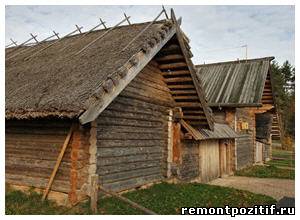
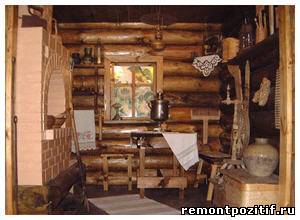
Mostly the walls of the hut were built of logs, the roof could be thatched or wooden, the windows - mowed (with frames) or drag (cut through the logs). For usually used hoglupen (carved ridge); the facade was decorated with window frames, towels and moorings; walls, doors, ceiling and stoves - characteristic Slavic ornaments in the form of animals, birds, plants and geometric patterns.
By the way, the carved ridge on the roof was not used by the Slavs for beauty. The fact is that, thus, the Slavs brought to the Gods a "building sacrifice" in the form of a hut in the shape of a horse: four corners - legs, a house - a body, a horse - a head. Such a sacrifice symbolized the creation of something intelligently organized from the primitive chaos (tree) (). Often, a tail from a bast was also tied to the back of the ridge - in this case, the dwelling, according to the Slavs, was completely likened to a horse. Besides, archaeological excavations showed that the very first huts were not decorated at all with carved skates, but with real horse skulls.

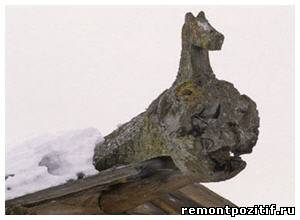
Over time, the dimensions of the hut increased: in addition to the hut itself, a room appeared, which was separated from the main dwelling by a wall. These are called "five-wall". In the northern regions, six-walled and twin huts began to appear, which are two independent log-cages with a common canopy and covered with a common roof. Often light galleries adjoined the huts, which connected residential buildings, storerooms and workshops, which made it possible, without going outside, to move from one room to another.
Slavic houses could have several options for blocking the economic part from. It could be a single-row tie, which was called "Under one horse"(that is, the household and living quarters were under the same roof); double-row connection - "Two horses"(the outbuilding and the hut were covered with separate roofs with parallel ridges); three-row communication - "For three horses"(the hut, the utility block and the courtyard stood side by side and were covered with separate roofs with three parallel ridges). most often they were gable, however, hip or hip-shaped roofs could also be found.
Khata - the traditional dwelling of the South Slavic peoples
To some extent, the hut is akin to a hut with the difference that more solid and insulated huts were built mainly in northern regions Slavic settlements, while in the southern regions (in Ukraine, Belarus and partly in Poland), huts predominated - lighter types. The huts could be wattle, log cabins, adobe, etc. Inside and outside, as a rule, they were coated with clay and whitewashed. Like the hut, the hut usually had a living room with a stove, a canopy and a utility block.
The main difference between a hut and a hut is that it is not built from whole, but from half or other lumber, which is then coated with adobe - a mixture of straw, horse manure and clay. It should be noted here that adobe is not at all an obligatory element of the hut: in more prosperous villages and in later times, huts could be upholstered with roofing iron and painted in bright colors (most often a combination of blue and white). The traditional adobe hut was coated with white clay or whitewashed with chalk outside and inside.

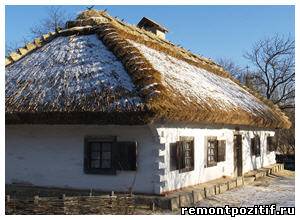
It is curious that by the word "khata" the Slavs meant not only itself, but also its parts - there were such concepts as back and front hut... The back hut was half of the house, the windows of which overlooked the courtyard. At the front hut, the windows looked out onto the street. The back and front huts were usually separated by either a simpler and coarser Ukrainian stove, which stood in the middle of the room, and / or a wall partition in the form of a wicker or wooden frame coated with clay. At the same time, the front hut played the role of a ceremonial room intended for meeting guests, resting and placing icons, and the back one carried the economic burden - they cooked food here, and in severe frosts they could warm young cattle. In some cases, the part of the rear hut adjacent to the stove was fenced off with a separate partition and received something similar to a separate kitchen.
Usually the hut was equipped with a straw one, which protected the dwelling from snow and rain, but at the same time provided natural ventilation of the room. An indispensable element of all huts were shutters that could be closed in hot and sunny weather. In rich dwellings, the floor was plank (with a high underground), in poorer dwellings, it was earthen. As for the materials for the construction of walls, their choice largely depended on natural conditions this or that locality. For example, in Ukraine, forest reserves are rather scarce, therefore, when building houses (most often huts), they tried to use a smaller amount of wood.

